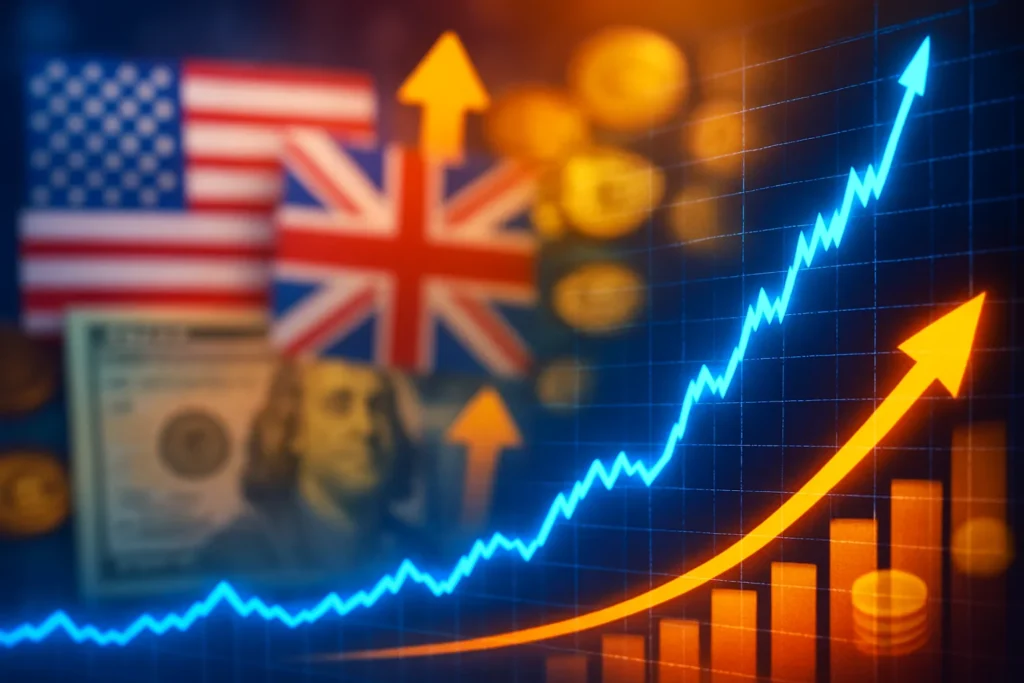Momentum Returns to Markets Amid Uncertainty
The trading floors of London and New York pulsed with renewed energy this week, stirred by the unexpected harmony of monetary policy shifts and the prospect of a major transatlantic trade pact. The Bank of England’s decision to cut interest rates by 0.25%, while coupled with a flurry of Wall Street optimism about an impending US-UK trade deal, has catalyzed rallies across indices from the FTSE 100 to the S&P 500.
Analysts describe this convergence as both a relief rally and a cautious embrace of hope. Yet, hope comes bundled with uncertainty. The Bank of England’s Monetary Policy Committee was notably divided: some members pushed for a more aggressive cut, while others argued for stability. Sterling, after an initial surge, retreated—an apt metaphor for investors’ see-sawing emotions as trade talks churn behind closed doors. According to Dr. Fiona Mason, senior economist at the Centre for European Reform, “Rate cuts alone aren’t a panacea: the markets want clarity on transatlantic trade rules, especially in a post-Brexit world where old certainties are gone for good.”
Why such market euphoria over just a framework deal? The Trump administration brands the agreement “full and comprehensive,” but details are still scant, and past experience tells us the devil is always in those details. The deal is projected to reduce tariffs on major items like cars and steel, while purportedly offering relief for digital giants (think Google, Amazon, and Apple) beset by Europe’s digital tax. Investors once wary of back-and-forth tariff wars are now recalibrating their outlooks, cautiously optimistic—but with one eye open.
Winners, Losers, and Lingering Questions
Not all companies are positioned to benefit equally. Sectors exposed to US growth—luxury autos, defense, and hospitality—surged on news of tariff relief and a friendlier investment climate. Aston Martin, which had previously suspended US exports due to burdensome costs, rallied by more than 11%. Consumer-facing giants like Next delivered surprising sales bumps, and InterContinental Hotels Group reported strong bookings. Rolls-Royce, BAE Systems, and UK pharma leaders GSK and AstraZeneca sit at an uncertain crossroads; their vast American operations make them sensitive to every regulatory twist and turn.
Yet storm clouds remain. Warm weather slamming energy shares, and the prospect of US tariffs lingering on Chinese goods, remind us these are not normal times. On the American side, Treasury Secretary Scott Bessent subtly reminded markets that the US-UK agreement is neither the first nor the last: with seventeen other major deals being negotiated, trade turbulence is the new status quo. “The ongoing US-China standoff on tariffs and tech only reinforces how fragile global growth still is,” warns Harvard economist Linda Foxworth. “Temporary rallies can’t disguise structural uncertainty.”
“Markets may rally on headlines, but until working families see real wage growth and affordable imports, these deals remain boardroom victories, not kitchen table ones.”
A closer look reveals that beneath the market’s exuberance lies an unspoken truth: big business may be first in line for benefits, but workers and consumers often must wait. Will easing tariffs translate into job growth and lower prices for ordinary people, or primarily bolster profit margins? Past trade frameworks—from NAFTA to USMCA—offered grand promises of prosperity, yet the benefits have often been distributed unevenly, fueling inequality and resentment.
The Real Stakes: Progress and Pitfalls
Progressive critics highlight the broader implications of these economic maneuvers for justice and equity. Lower interest rates might give some families a breather on mortgage payments, but trickle-down prosperity is hardly guaranteed—especially when monetary stimulus coincides with regressive tax cuts or weak consumer protections. As trade barriers fall, regulatory standards and worker rights must not follow them down.
History offers a cautionary tale: after the 2008 crisis, global stimulus helped prevent deeper collapse, but austerity and unchecked deregulation exacerbated inequality. Today’s recovery efforts risk echoing those same mistakes if they fail to put ordinary people ahead of corporate power. As London investor Yasmin Patel puts it, “Trade deals should mean secure jobs, rising wages, and the ability to plan for the future—not just ticker-tape parades for investors.”
Global dependence on smooth technology trade flows suggests both opportunity and danger. U.S.-UK cooperation on digital taxes and cross-border data flows could set progressive precedents, expanding online rights and data protections—or, more cynically, eroding safeguards in favor of megacorporations. “What matters is who gets a seat at the table when these agreements are drafted,” notes digital policy expert Eliza Han. “We need a framework that uplifts small businesses and workers, not just Fortune 100 CEOs.”
Markets now look to Washington and Westminster for leadership, demanding transparency and follow-through. Investors hope for a cascade of matched agreements, but progressive voices urge vigilance: without robust environmental standards, labor protections, and honest consultation, every new deal risks widening the divide between rhetoric and reality.

